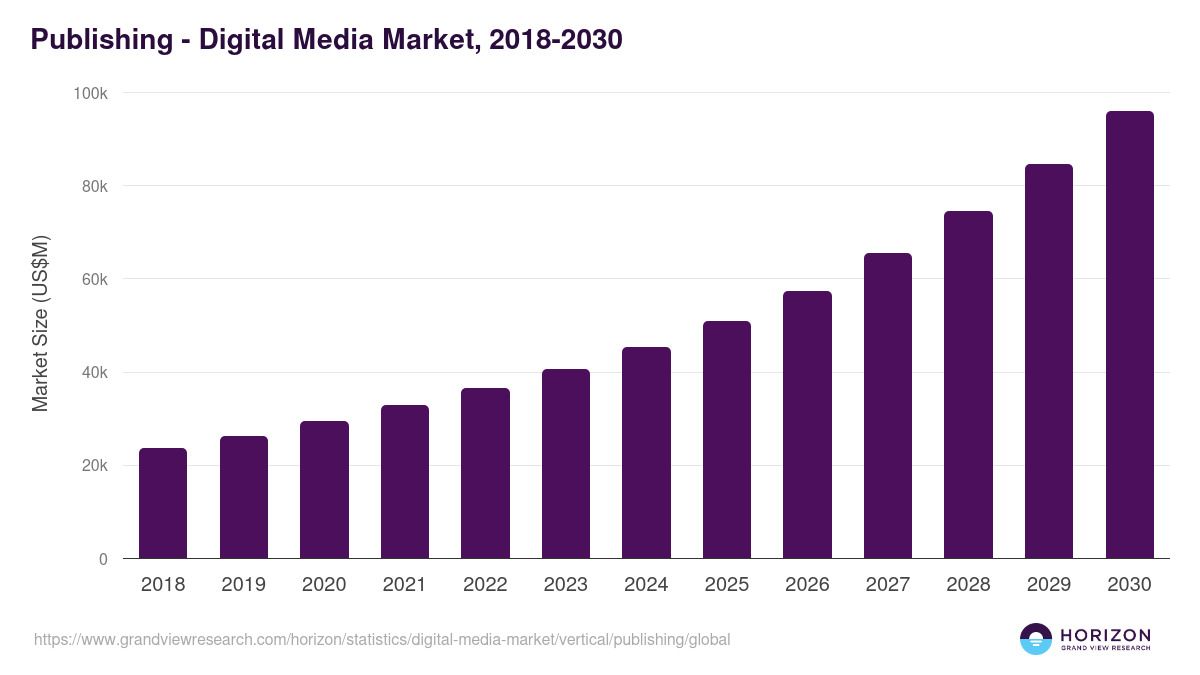Global Publishing Industry Trends: 2025 Outlook
An
The publishing industry, often seen as traditional, is undergoing a profound transformation across all major markets. While print still holds cultural prestige, the digital tide is reshaping formats, distribution, revenue models, and even reader expectations.
Here’s a breakdown of the most significant global trends in publishing, backed by data and insights.
Digital Publishing Is No Longer Optional but Foundational
The global publishing digital media market size was valued at US$ 45,355.8 million in 2024 and is estimated to grow at a compound annual growth rate (CAGR) of 13.3% from 2024 to 2030. [Ref - grandviewresearch]
- Ebooks and audiobooks continue to see double-digit growth, especially in the U.S., India, and parts of Africa.
- Subscription services like Kindle Unlimited, Scribd, and regional players like Storytel are redefining access and monetization.
Publishers must now treat digital-first strategies as core, not auxiliary. Print-only models are losing ground, especially in Gen Z and millennial markets.

Audiobooks Are the New Growth Engine
The global audiobook market is expected to surpass $35 billion by 2030, growing at over 26% CAGR (Source: WordsRated, Deloitte).
- Markets like India (+43% YoY) and Brazil (+28%) are seeing rapid listener adoption.
- Spotify and YouTube have entered the audiobook race, creating direct-to-consumer channels that bypass traditional publishers.
Publishers must reimagine content as multi-format IP. One manuscript can now be monetized across print, ebook, audio, podcast, and video adaptations.
Self-Publishing and Indie Authors Are Gaining Serious Market Share
Amazon’s Kindle Direct Publishing (KDP) reported over 1.5 million new titles added in 2024. Nearly 50% of all ebook sales in the U.S. are now from independently published authors.
- Platforms like Draft2Digital, Reedsy, and Wattpad are enabling creator autonomy.
- High royalty rates (up to 70%) and global reach make indie publishing lucrative.
The gatekeeping power of legacy publishers is weakening. Talent discovery is now algorithm-driven and community-led.
AI-Generated Content Is Disruptive but Also Risky
AI tools are being used for draft generation, translations, summarizations, and cover design.
According to PwC, 38% of publishing executives plan to integrate generative AI into workflows by 2026. However, IP concerns and originality debates persist.
AI is an accelerant, not a replacement. The future belongs to publishers who blend human creativity with machine efficiency, ethically.
Regional and Multilingual Content Is Exploding
In India, regional language content (Hindi, Tamil, Bengali, Marathi) accounted for 60% of new book sales in 2024 (Source: Nielsen BookScan India).
- African markets are witnessing a rise in Swahili and Hausa-language publishing.
- Latin America is expanding Spanish digital publishing outside Spain’s traditional dominance.
The next billion readers are multilingual and mobile-first. Localization is no longer a translation task; it’s a strategic growth pillar.
BookTok and Reader Communities Are the New Marketing Channels
TikTok’s #BookTok hashtag has over 215 billion views globally. This trend:
- Has led to backlist books (e.g., Colleen Hoover) topping bestseller charts years after release
- Drives 7x more sales conversions than traditional ads for YA and romance genres
Influence has shifted from critics to communities. Publishers must prioritize creator collaborations, not just media reviews.
The global publishing industry is at a pivotal inflection point. While the traditional value chain is being disrupted, new frontiers in audio, AI, creator-led publishing, and localization are offering fresh opportunities. The publishers who innovate without losing editorial integrity, and diversify formats and markets, will not just survive but lead.
